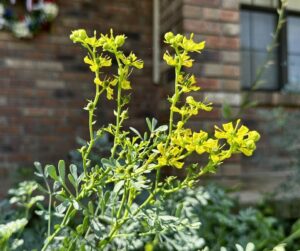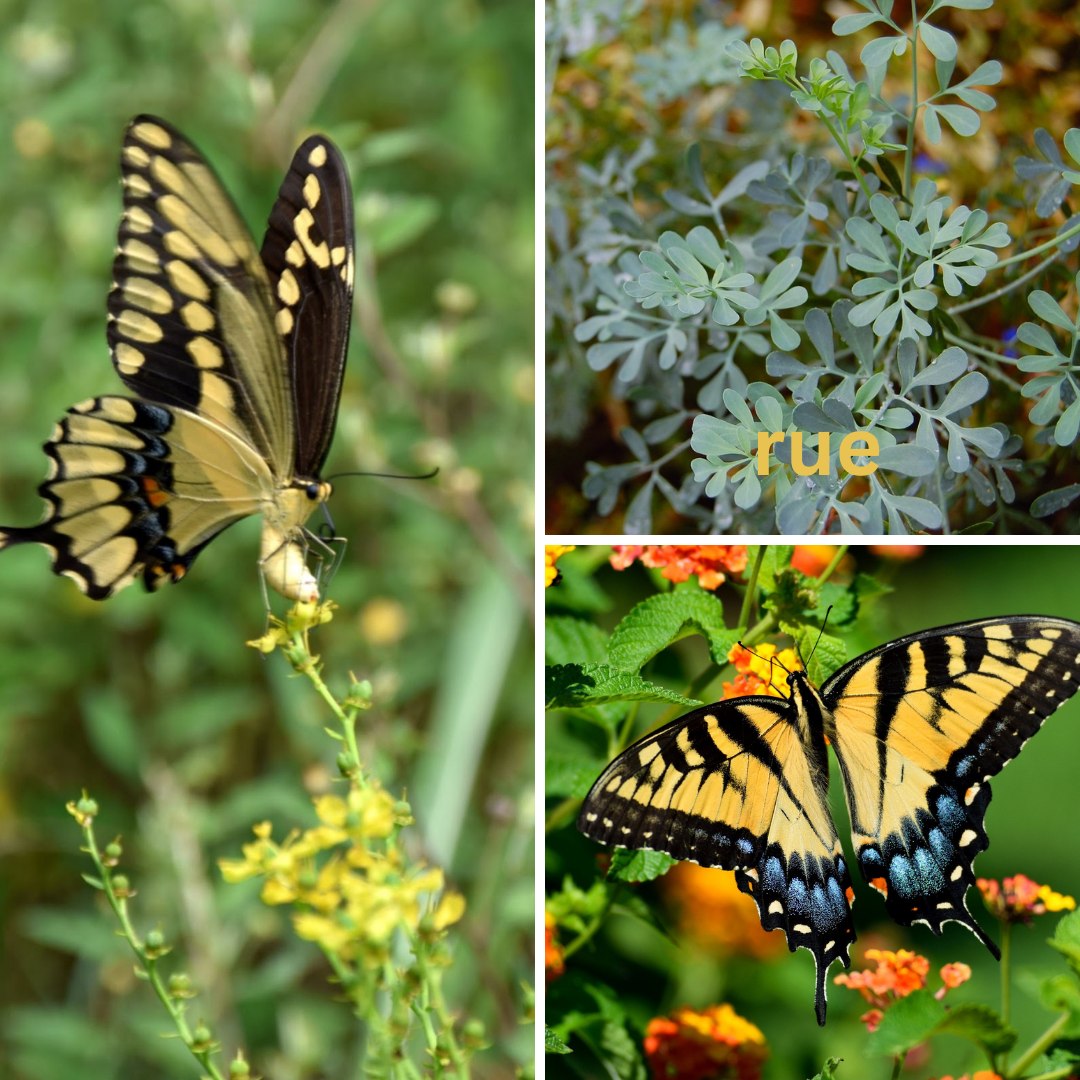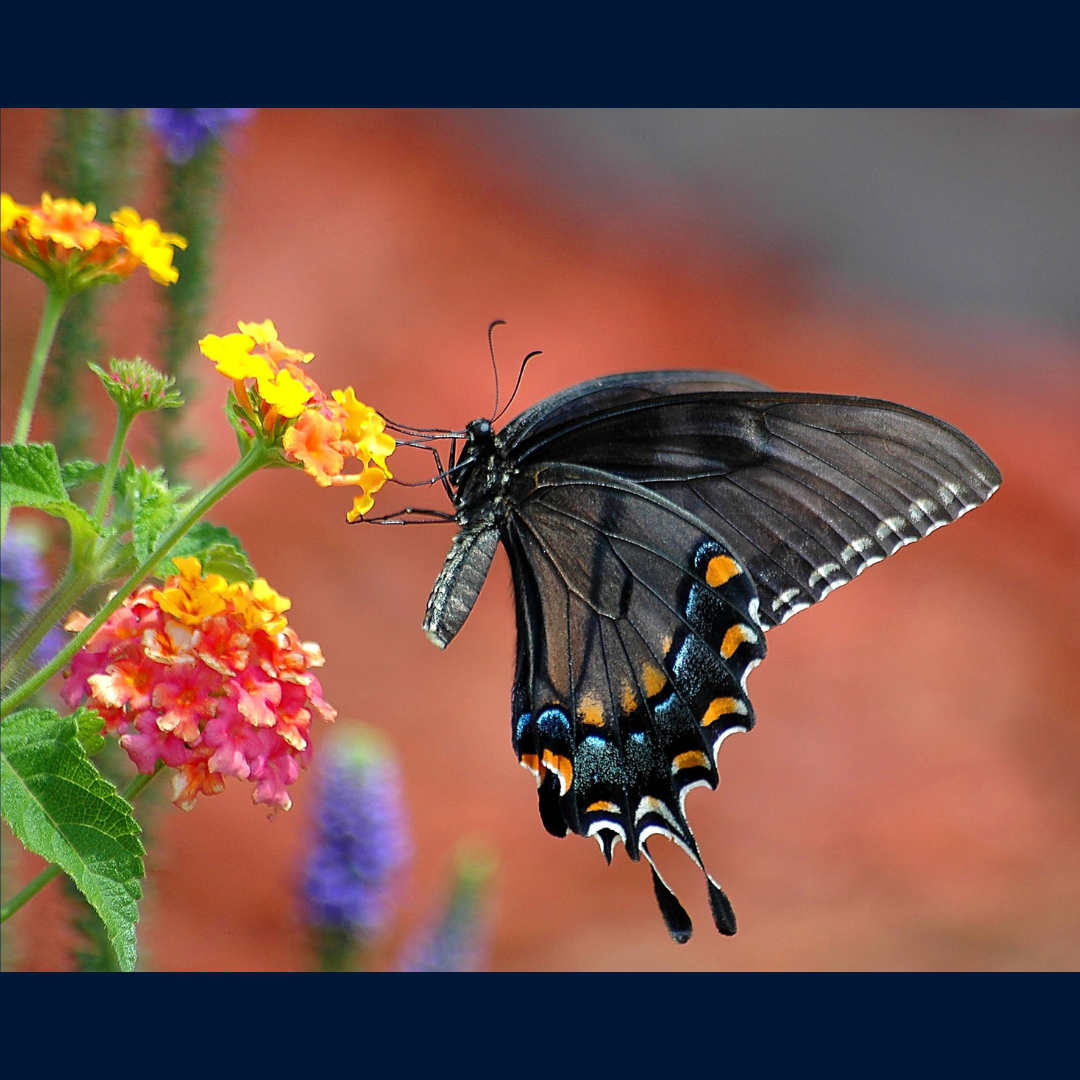
Rue Growing in Jacki Kellum’s Garden – 2023
Apparently, rue is the only plant that the former occupants of my house planted. Rue is a an old, Biblical-times plant that was essential at that time. In the USA, it has lost favor among most gardeners, but the former occupants of this house moved here from the Bible Lands, and clearly, they valued this herb. I’m researching this plant now to try to discern the value of rue, but if for no other reason, I’ll grow more of this herb because it is a host plant for some of the swallowtail butterflies–Black Swallowtail and the Giant Swallowtail and others. Both the Black Swallowtail and the Giant Swallowtail are adundant in Mississippi.

On September 19, 2023, I noted the following:
“I have at least 30 caterpillars for Giant Swallowtail Butterflies on a small, insignificant rue plant near my front door. Last month, this same plant was covered with caterpillars for Black Swallowtails. The significant thing is that rue is a woody, almost ugly little bush. At times, it has tiny little yellow flowers, but mine is usually just plain and green, I have come close to yanking my rue plant several times. Thank goodness I did not. It is the best butterfly-producer in my yard.”

For years, I jumped through hoops, trying to attract monarch butterflies to my garden. One year, I was successful, but never seemed to have enough milkweed to sustain them. Imagine that I do have a ready supply of rue growing in my current yard, and rue is the host plant for some of the gorgeous swallowtail butterflies. In my opinion, the swallowtails are the most exotic among the common butterflies that frequent my garden.
Bottom Line: I’ll continue growing rue for these gorgeous creatures.
Rue is an ancient herb. It was highly valued during the time of the Bible:
Luke 11:42
42 “Woe to you Pharisees, because you give God a tenth of your mint, rue and all other kinds of garden herbs, but you neglect justice and the love of God. You should have practiced the latter without leaving the former undone.
“rue. A small, woody, perennial shrub (prob. Ruta graveolens), noted for its pungent, bitter leaves and yellow flowers. Of the four varieties grown, the species graveolens, meaning “strong smelling,” is the most common, indigenous to the E Mediterranean coast. It was relished for its peculiar strong taste and used as a culinary spice and for medicinal reasons. It was a customary tithable garden plant (Lk. 11:42).” Zondervan Copyright © 1987, 2011 by Zondervan.
In other words, rue was a valuable commodity during Biblical times.
“Keep it far away from sweet basil; plant near roses and raspberries; deters Japanese beetle.” (Hylton, pg. 269)
“Rue is a hardy perennia about two feet in height…very offensive to pests…. Rue spreads readily and will help dispel insect troublemakers among vegetables, flowers, shrubs, or fruits.” (Hylton, pg. 278)
“Rue-the herb of grace- has been used as an herbal medicine for thousands of years. It was prescribed for at least eighty-four different ailments in Pliny’s day. Its generic name, Ruta, derives from a Greek word meaning ‘to set free,’ ….
“Rue was famous as an antidote to poisons of all kinds.
“Gerard wrote: ‘If a man be annointed with the juice of rue, the poison of wolf’s bane, mushrooms, or todestooles, the biting of serpents, stinging of scorpions spiders, bees, hornets and wasps will not hurt him.’ [John Gerard was an English herbalist who lived from 1545-1612.] (Hylton, pg. 555)
“Ruewater was sprined about the house to kill fleas. And it was also placed or grown near stables or around manure piles to repel flies. …
“Pliny tells us that Greek painters used rue to achieve a second sight and to relieve their eyes after working long hours in dim light.” (Hylton, pg. 557)
Hylton, William H., and Nelson Coon.THE RODALE HERB BOOK: HOW TO USE, GROW, AND BUY NATURE’S MIRACLE PLANTS. 1974.
The following is from Culpeper’s Complete Herbal
 |
|
Published in 1653 [Many of these uses of rue are currently in dispute]
GARDEN-RUE.
“Garden-rue is so well known by this name, and the name Herb of Grace, that I shall not need to write any farther description of it, but shall shew you the virtue of it, as follows.
“GOVERNMENT AND VIRTUES.] It is an herb of the Sun, and under Leo. It provokes urine and women’s courses, being taken either in meat or drink. The seed thereof taken in wine, is an antidote against all dangerous medicines or deadly poisons. The leaves taken either by themselves, or with figs and walnuts, is called Mithridate’s counter-poison against the plague, and causes all venomous things to become harmless; being often taken in meat and drink, it abates venery. A decoction thereof with some dried dill leaves and flowers, eases all pains and torments, inwardly to be drank, and outwardly to be applied warm to the place grieved. The same being drank, helps the pains both of the chest and sides, as also coughs and hardness of breathing, the inflammations of the lungs, and the tormenting pains of the sciatica and the joints, being anointed, or laid to the places; as also the shaking fits of agues, to take a draught before the fit comes. Being boiled or infused in oil, it is good to help the wind cholic, the hardness and windiness of the mother, and frees women from the strangling or suffocation thereof, if the share and the parts thereabouts be anointed therewith. It kills and drives forth the worms of the belly, if it be drank after it is boiled in wine to the half, with a little honey; it helps the gout or pains in the joints, hands, feet or knees, applied thereunto; and with figs it helps the dropsy, being bathed therewith: Being bruised and put into the nostrils, it stays the bleeding thereof. It takes away wheals and pimples, if being bruised with a few myrtle leaves, it be made up with wax, and applied. It cures the morphew, and takes away all sorts of warts, if boiled in wine with some pepper and nitre, and the place rubbed therewith, and with almond and honey helps the dry scabs, or any tetter or ringworm. The juice thereof warmed in a pomegranate shell or rind, and dropped into the ears, helps the pains of them. The juice of it and fennel, with a little honey, and the gall of a cock put thereunto, helps the dimness of the eye-sight. An ointment made of the juice thereof with oil of roses, ceruse, and a little vinegar, and anointed, cures St. Anthony’s fire, and all running sores in the head: and the stinking ulcers of the nose, or other parts. The antidote used by Mithridates, every morning fasting, to secure himself from any[160] poison or infection, was this: Take twenty leaves of rue, a little salt, a couple of walnuts, and a couple of figs, beaten together into a mess, with twenty juniper berries, which is the quantity appointed for every day. Another electuary is made thus: Take of nitre, pepper, and cummin seed, of each equal parts; of the leaves of Rue clean picked, as much in weight as all the other three weighed; beat them well together, and put as much honey as will make it up into an electuary (but you must first steep your cummin seed in vinegar twenty four hours, and then dry it, or rather roast it in a hot fire-shovel, or in an oven) and is a remedy for the pains or griefs in the chest or stomach, of the spleen, belly, or sides, by wind or stitches; of the liver by obstructions; of the reins and bladder by the stopping of urine; and helps also to extenuate fat corpulent bodies. What an infamy is cast upon the ashes of Mithridates, or Methridates (as the Augustines read his name) by unworthy people. They that deserve no good report themselves, love to give none to others,VIZ.That renowned King of Pontus fortified his body by poison against poison. (HE CAST OUT DEVILS BYBeelzebub,PRINCE OF THE DEVILS.) What a sot is he that knows not if he had accustomed his body to cold poisons, but poisons would have dispatched him? on the contrary, if not, corrosions would have done it. The whole world is at this present time beholden to him for his studies in physic, and he that uses the quantity but of an hazel-nut of that receipt every morning, to which his name is adjoined, shall to admiration preserve his body in health, if he do but consider that Rue is an herb of the Sun, and under Leo, and gather it and the rest accordingly. Culpeper, 1653
From what I have read, fresh rue can blister the skin, and if it is ingested in high quantity, it can have adverse effects. Although we should use rue with caution, Texas Master Gardener Andi Wardlow calls it a perfect plant:
“Overall, I give Rue a 10 rating. As far as plants go, it’s about as perfect as a plant can be, it has beautiful foliage, stays green year around, thrives on neglect, drought tolerant, versatile and isn’t bothered by disease’, pests, deer and rabbits. Now that is what I call a great plant.” Andi Wardlow
Rue (Ruta graveolens)
An Overlooked, Underused Herb
By Andi Wardlaw, Master Gardener
“In ancient times, Rue was an important culinary and medicinal herb. Rue was a common cooking herb for the Romans and commonly used in a spicy seasoning paste that contained garlic, hard cheese, coriander, and celery seeds with Rue leaves. The botanical, Latin name of “Ruta” comes from Greek, translated as “to set free,” referring to its use as a chief ingredient in mixtures used as antidotes to poisoning.
“It was a common herb believed to keep away witches, and that folk use evolved into the Catholic Church’s practice of dipping branches of rue into Holy water and sprinkling it over the heads of parishioners as a blessing, which earned it a common name for the plant of “herb of grace.”
“Domesticated Rue should not be mistaken for African Rue which was an introduced, deep-rooted, perennial plant in the Caltrop family (plants with spiked seed casings). The forage value of this plant is poor for livestock and wildlife, and the plant is extremely unpalatable, poisonous to livestock and is consumed only when animals are starving. This plant has become an invasive plant in parts of the country and difficult to eradicate.
“Domesticated Rue has fallen out of use in today’s cooking primarily because our taste preferences and choices have changed. In the past, the use of an herb that imparted a bitter undertone to a dish, balancing the sweet, sour, salty, and hot flavors was important, but it is less so today. In today’s world culinary selections are endless therefore what was commonly used in the past can be replaced with tastes more individually suited to a palate. Occasionally you’ll still find Rue used in Italian dishes, mostly among Old Italian families that have passed down recipes through generations of cooks.
“It’s most commonly used today in Ethiopia as both a cooking herb and an addition to coffee. Both the leaf and the seed, are an important addition to brewing a pot of traditional Ethiopian coffee. Due to the plants low use as a culinary herb, Rue has fallen out of grace in the garden. Thus, this has become the forgotten herb.
“This heirloom herb remains virtually unchanged since ancient times. There has been no hybridizing or even selecting out strains of the plant. What you grow in your garden will be a direct descendant of the same plant found growing in its native habitat of the Mediterranean region and parts of Western Asia.
Rue’s fragrance is aromatic and bittersweet, which some people find unpleasant, and the raw leaves have a very mild numbing effect on the tongue. The fresh leaves are less strong than the dried leaves, and the seeds have a slight hotness, too.
“While there are many folk medicine and homeopathic uses for Rue, most current medical resources caution against using the herb. The primary reason appears to be the danger of using too much.
“If for no other reason, grow Rue as a favored host plant for both the Black Swallowtail and the Giant Swallowtail butterfly caterpillars. As with other host plants, the “guests” will feast on the plant and at times leave the plant devoid of many leaves. However, this is well worth the naked looking plant, which won’t look sparse for long, since the plant is quick to rebound. With natural wildlife habitats on the decline it is important to incorporate host plants in the garden.
Evergreen Shrub
“Rue (Ruta graveolens) is an evergreen herb or small shrub with bluish-green leaves. The plant has a clumping habit, growing to 20-30 inches tall. It does best in full to part sun, with at least 6 to 7 hours of sunlight per day, and well-drained soil. It will even thrive in extremely dry conditions once established, but over-watering will kill the plant.
Hardy Perennial
“It’s hardy from upper Zone 6 and warmer. There’s no need to fertilize the plant, it’s perfectly happy in very poor soil. Growing this underused plant is as simple as starting from seed, placing cuttings in damp soil or by starting cuttings in water. Be aware that Rue seeds can, but not always, have a tendency to be slow to sprout.
“Rue is a perennial that has a life span of 5-6 years; however, I have had the same rue plants in the garden for almost ten years. The plants are pruned down to 3-4 inches in late winter and within a couple of weeks the plants look strong and healthy.
“Although some winters we have hard freezes that can last several days Rue stands its ground. A long-lasting hard freeze can make the plant droopy, but as soon as the temperatures warm, the plant perks back up.
“Knowing that this herb is evergreen in our area gives it a wider potential for use in the garden. Think outside the box and instead of planting this usual evergreen shrub as an accent plant, consider a border using Rue. Remember it is very drought tolerant and evergreen making this a great addition to the garden for winter interest. As with many strong-smelling plants deer and rabbits leave it alone.
Not Invasive
“While it can reseed itself, it’s seldom invasive and can be controlled by simply snipping off the seed heads after it blooms. Consider letting the flowers go to seed to share with friends or starting plants in other areas of the garden.
“The one thing to be careful of is that it can cause a skin allergy in sensitive people. This usually only happens on hot, sunny days when a person is sweaty while handling Rue in the sun. Rue has gotten a bad reputation because of its potential for contact dermatitis. Cautions, while sincere, are considerably over-stated. Personally, I have never had a reaction to Rue, but do be aware of a possible reaction. If in doubt about a reaction, consider wearing gloves or working with the plant during the cool morning or evening hours.
“Overall, I give Rue a 10 rating. As far as plants go, it’s about as perfect as a plant can be, it has beautiful foliage, stays green year around, thrives on neglect, drought tolerant, versatile and isn’t bothered by disease’, pests, deer and rabbits. Now that is what I call a great plant.”
Wardlaw, Andi. “Rue an Overlooked Herb.”RANDALL COUNTY MASTER GARDENER ASSOCIATION, txmg.org/randall/staying-connected/gardening-with-the-masters/gardening-tips-2/rue-an-overlooked-herb. Accessed 4 July 2023.
Discover more from Jacki Kellum
Subscribe to get the latest posts sent to your email.